This article was first published on Hroarr in 2016.
Sparring and free play are important tools on our way to becoming more competent fencers, while at the same time the approaches and views on how to achieve this vastly differ.
Some clubs hit it pretty hard with full kit when sparring time comes, others are going nice and slow with mask and glove only and some do not utilize masks at all, going at a really slow speed and intensity. There are also quite a lot of shades between, with some clubs doing most of their training with minimal equipment and only gearing up from time to time or with the more experienced fencers.
This leads to an endless debate, with some fencers being concerned about a lack of “realism” when they reduce the intensity of free play. They claim that you need to apply close to your full speed and strength to properly test your skill, even if that might result in the need for quite a lot of equipment and possibly a higher injury rate. Other fencers are of the opinion that a sharp sword doesn’t need to be used with as much strength anyway, and thus being more concerned about safety, do not hit as hard.
Each side have some valid points, but how hard should we spar and hit each other, what is the proper level of force* and when do we give it 100%?
The conclusion from this articles research is, in short, you don’t.
The slightly longer answer is, you might not even want to go beyond 70% – 85% force.
For the full answer, I researched how full contact martial arts handle sparring intensity and interviewed coaches that train athletes for amateur and professional fights in Mixed Martial Arts (MMA), Dog Brothers Martial Arts (DBMA), Brazilian Jiu-Jitsu (BJJ), Luta Livre, Freestyle wrestling, Kendo and, of course, HEMA **.
This article isn’t meant to be a representative sample of these sports or martial arts training in general by any means, not the least since it’s a rather small sample. However it should still give you some food for thought and provide new arguments to the debate.
I wrote this article mostly with longsword in mind, since it’s one of our most popular HEMA disciplines and has a larger damage potential than, for example, Rapier, but it might apply to other disciplines as well.
Let me make some points clear though; I’m not ranting about tournaments here or the very occasional “Ok dude, let’s really go for it!”, but rather the regular sparring in our clubs that we do week in week out, since you can get away with a lot of dangerous or unhealthy activities if you just do them very occasionally (not that I’d necessarily advise to), but it’s the bulk of our training we should take the closest look at.
Also tournaments might just be the place to give everything you have, but this is a whole other debate.
* Note: With 100% I mean hitting as hard as one can in a training situation, even though you might release even more power if you’re in a real life or death situation. With “force” I mean how hard your partner perceives the hit, regardless if this is the result from applied muscle strength, the acceleration and speed of the sword or a combination of both.
** I conducted these interviews from December 2014 to February 2015.
Content
DBMA
Now let’s start with a weapons based art that also incorporates fencing masks and Roll- or Streethockey gloves in its bouts (but with another focus, we’ll come to that): The full contact stick fighting of the Dog Brothers, and the system derived from it called Dog Brothers Martial Arts.
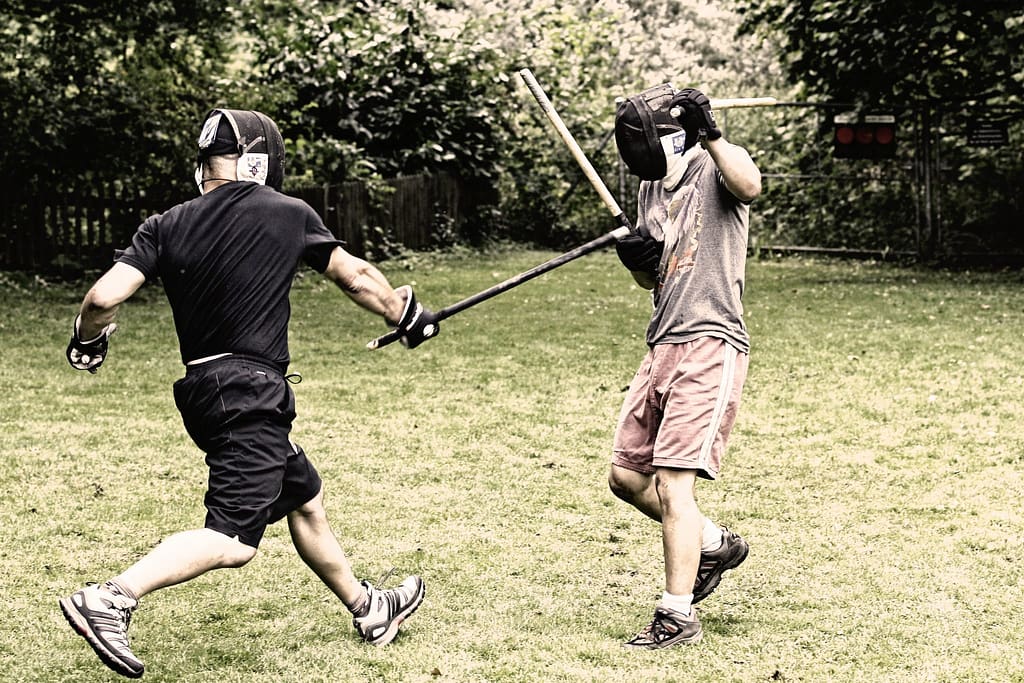
For those of you unfamiliar with it, they use mostly rattan sticks of various length and knife simulators, include unarmed kickboxing and grappling in their fights, and wear minimal protective gear. Most of the time only a fencing mask, light padded gloves and a cup, with optional elbow/knee protection are used.
Similar to us, what they have in mind is a Bloßfechten situation, even though they keep on fighting after hits to the head, unlike us HEMA folks that usually stop after a head or body hit and, at most, allow an after blow to take place. Their reasoning is that on the one hand, they don’t fight for points, but just to learn. So keeping on fighting helps them to extend that opportunity and also, that a real fight doesn’t necessarily stop after a head hit.
So situations like stick assisted ground fighting regularly happen in their fights and getting tapped out is a valid way of getting defeated.
The Dog Brothers meet on events called “Gathering of the Pack” and upload plenty of stuff on Youtube, so go watch one of their videos now
Done? Then you probably guessed by now that knockouts and laceration do happen and that hand injuries are common, even though they don’t try to injure each other deliberately [3]. A thing to note, is that not while DBMA originates from within the Dog Brothers, not everyone that fights on a Gathering is a Dog Brother or trains in DBMA, they’re open to any style. Also only a small amount DBMA practitioners are Dog Brother or fights at the Gatherings.
The Gatherings are a pretty rough environment and, intensity wise, at least on par with our most hard hitting tournaments. So to prepare for this kind of challenge, they must surely train really hard and do some very hard hitting sparring sessions right?
Not quite.
As it turns out, while they of course train really hard, hitting hard is reserved for tires and other tools. To a much smaller extent, hard hitting has a place in predetermined partner exercises, where it is very clear what the partner will do, so you have every chance to block the attack.
When asked about their sparring practices, Benjamin Rittiner aka Lonely Dog, leader of the DBMA headquarter in Europe, told me that they do mostly task-oriented sparring with 30% – 60% force and that as they get more cautious, more options are allowed in sparring.
When I asked him about anything beyond simple bruising, like broken bones, damaged joints or torn ligaments, Benjamin added that they have “surprisingly little” injuries in their training and during their gatherings, considering what they do.
It’s also interesting to note that the full contact sparring progression he uses has sparring with 70% – 80% force as the very last phase, so they don’t venture beyond that in their regular training.
More is reserved for their Gatherings, in which participation is of course entirely optional and according to Benjamin, only about 10-30% of his students fight there, while all of them spar regardless of age or gender.
BJJ & Luta Livre
Let’s continue with BJJ and Luta Livre Esportiva. What they both have in common are tournaments that involve throws, takedowns and the continuation of the fight on the ground with various submissions, like joint locks and chokes. While there are no strikes and punches allowed, they are full contact in the way of throw and takedown application power.
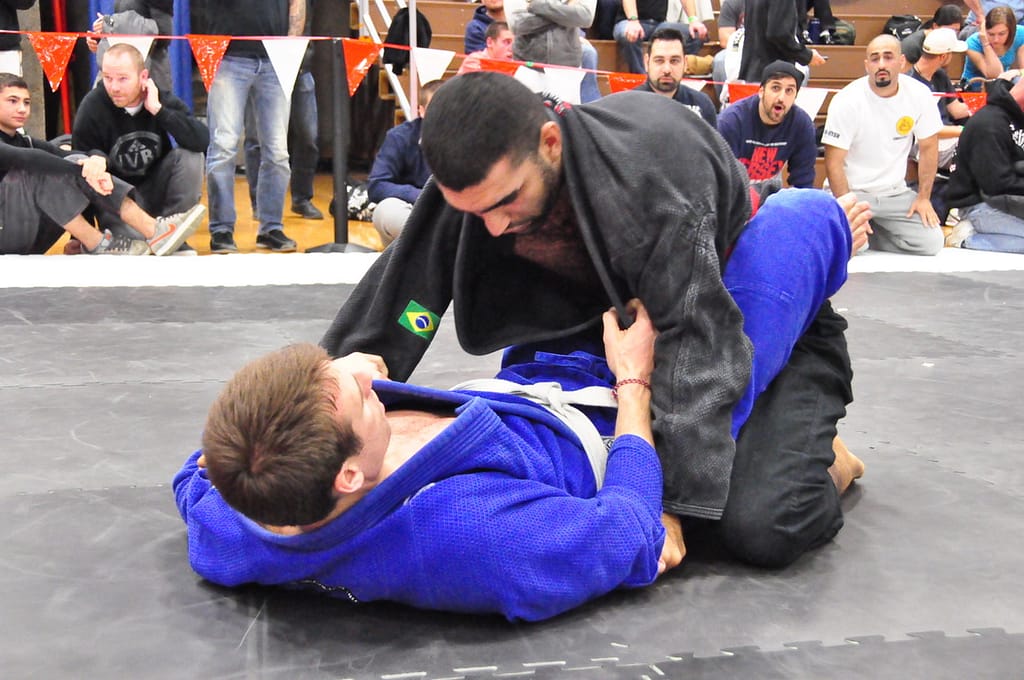
The basic idea once the fight gets to the ground is to get your opponent to give up the fight.
You do this by applying a submission to your opponent that will either choke him or bring his joints (or whatever else there is to break) to the point of damage, which will result in him either escaping or signaling his surrender by tapping. In a tournament or training setting that’s the point were you let go of whatever hold you had, so no permanent harm will be done. (Well there’s other stuff to do like establishing positional dominance and not getting tapped yourself, but you get the idea.)
In a self defense situation or if he refuses to tap for whatever reason, you might not want to let go and continue the submmision, which will result in an injury or your opponent going unconsciousness.
Now this is a major difference compared to HEMA. An armbar applied with full force will break your arm, which is exactly the point of it, while a Zornhau with 100% force might not do any damage using a dull blade to someone wearing good protective equipment, but I still think it’s worth to look at how they handle their training.
For those of you unfamiliar with grappling, trying to prevent someone from breaking your arm or choking you might seem like a pretty dangerous spare time activity, but one of the first things you learn is to control the force and speed at which you apply any attacks and to immediately let go if your opponent taps.
That means you consciously give your training partner the opportunity to stop the fight, since you don’t really want to injure him in training, even if that sometimes means that he has a chance to escape he would otherwise not have.
With this mindset, practitioners are able to train techniques that would lead to horrible injuries when forcefully applied in a real fight, without constantly visiting the hospital themselves.
When asked about their injury rates, BJJ Black belt and Luta Livre Brown belt Frank Burczynski of IMAG e.V. Berlin told me that they never had any serious injuries in their grappling classes, and only a few in their MMA classes. This is quite impressive considering he has been teaching various martial arts (that also include JKD for example) for over 19 years.
Would this track record be possible if they routinely applied a lot of force and speed to every submission? I find this doubtful.
Getting injured is not fun and can lead to permanent damage, or the complete end of a sports career. While there are the rare cases of grapplers like Shinya Aoki, that purposefully hurt their opponents if they get the chance to [4], you can roll with pretty much everyone on every belt level in BJJ or Luta Livre and get out unharmed.
For me, when rolling with a BJJ purple belt for the first time, the ease at which he tapped me was a highly enlightening experience. Without relying on his superior strength or speed he used my own movements against me and lead me into multiple traps, by using better technique instead.
While not being too comparable to HEMA, isn’t this an ideal to strive for? Relying on good technique instead of muscling your way through a fight?
Wrestling
Let’s continue with a sport that’s more focused on throwing people around than BJJ: Wrestling. For this I asked a freestyle wrestler, that is currently active in Austrians federal league about his experiences, who goes by the nick of Period in the german Kampfkunst-Board and can be contacted there, but otherwise likes to remain anonymous.
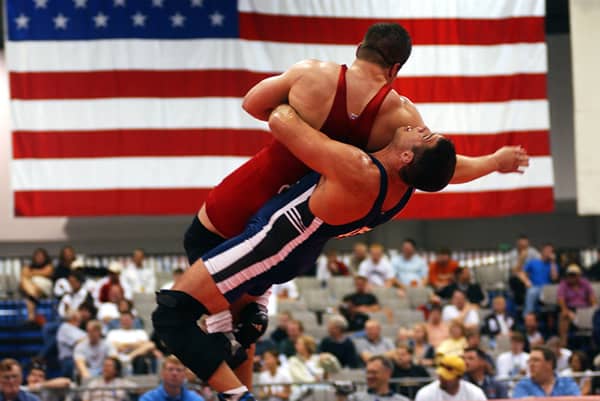
Now wrestlers aren’t generally known to be prissy when it comes to hard training and so he told me about a Russian training partner of his, who sparred hard enough to regularly draw the blood of both participants.
He also told me that a couple of other (very successful) wrestlers of the ‘Russian tradition’ (wrestlers who either come from the former Soviet Union themselves or who have been coached by such a wrestler) use a very relaxed, and action-reaction flow sparring as their main means of training.
He further explained that both schools of thought have their own reasoning: the „bruisers“ will claim that the harsh sparring is necessary to develop a high amount of toughness (which is why they will often actively seek out each other in training), while the “technicians” will argue that going rough too often likely impedes technical advancements, and contributes to a higher risk of injury.
Nevertheless he noted that the usual amount of intensity they spar with is between 60% – 80% force compared to the actual fight, with even lower intensities around 40-50% in the off-season. The speed on the other hand, usually goes up to 85% – 95% in tournament preparation.
With regard to injuries he told me that capsular tears, sprained ankles and hurt toes happen regularly during training, with bigger injuries mostly happening in tournament fights or, interestingly, during warmup or cool-down and not their actual wrestling training.
I guess the moral here is that you shouldn’t overdo any part of your training.
It should be noted here, that the level of force applied to throws and such can vary vastly between different martial sports or arts. So what a wrestler considers okay in friendly sparring, might not be okay for a Judoka. Still, there’s the same tendency, that regular sparring is done in a lighter way than tournament fighting.
MMA
So how’s it with MMA? You can watch any UFC and see some guys getting seriously beaten up. Surely at least they are hitting each other pretty hard in training, right?
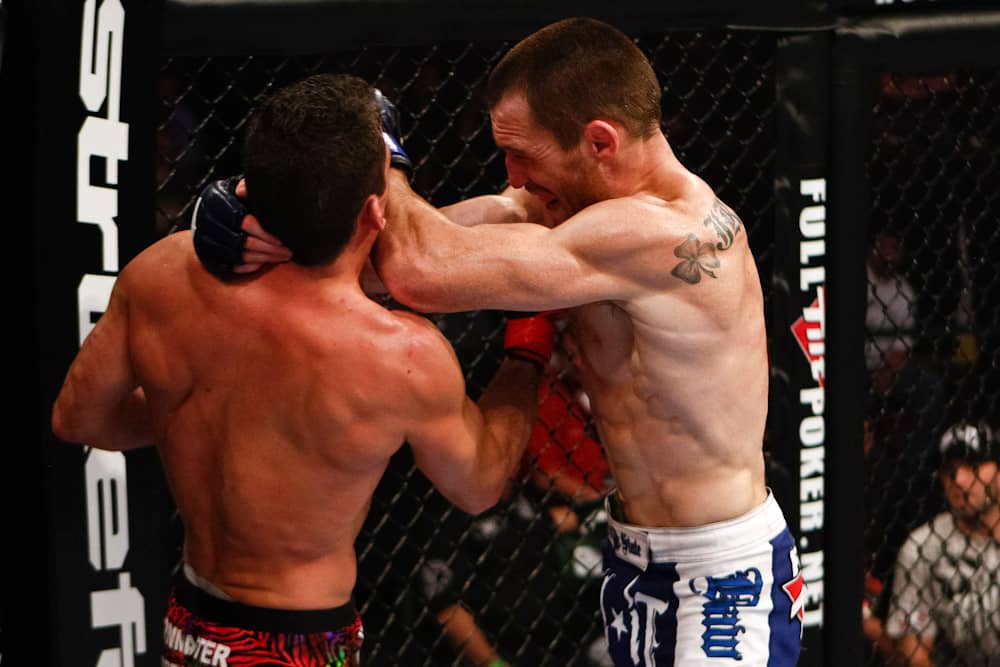
And while there might be some that do, you don’t have to search long to find a fighter like Robbie Lawler, who hasn’t sparred at all for years and Johny Hendricks (his opponent on UFC 171), who avoids head strikes in training at all costs by simply not doing any free sparring [1]. Yet they are still able to knock out trained professionals with their punches [8] [9].
Also Erik Paulson, who successfully competed in MMA himself and trained many great fighters like Ken Shamrock, Josh Barnett or Brock Lesnar, said, that back in his Vale Tudo days he used to train like he fought, so they went really hard during sparring which he now thinks was “stupid” and lead to constant injury and he advocates against it now[6].
A factor to consider here is that harder sparring in sports like Boxing, MMA or Muay Thai usually involves additional protection like headgear or shin guards. This might not come as a surprise to those of you training in that sport, but for everyone else: repeated hits to the head can lead to serious long term brain damage, on which Keith Farrel did an excellent aggregation for the HEMA side of things [2].
As you can see he uses additional protection as well and, I would argue, a slower pace and good bit less force than in his MMA fights.
MMA is interesting in that it has a major financial background, is still evolving today and it doesn’t have to comply with any traditions when it comes to training. This leads to the professionals having the time, skill and money to train with almost everyone they want, in any form they deem helpful. Still, it seems that at least some of them don’t feel the need to go as hard as they can during sparring.
Kendo
So far I’ve found, that there are some distinct differences in DBMA, BJJ, Luta Livre, Wrestling and MMA between the intensity of regular club sparring and a tournament setting, which of course might only be attributed to my sample selection, but this still forms an interesting picture.
Let’s look at one last example in the form of Kendo, before we take a look at HEMA itself.
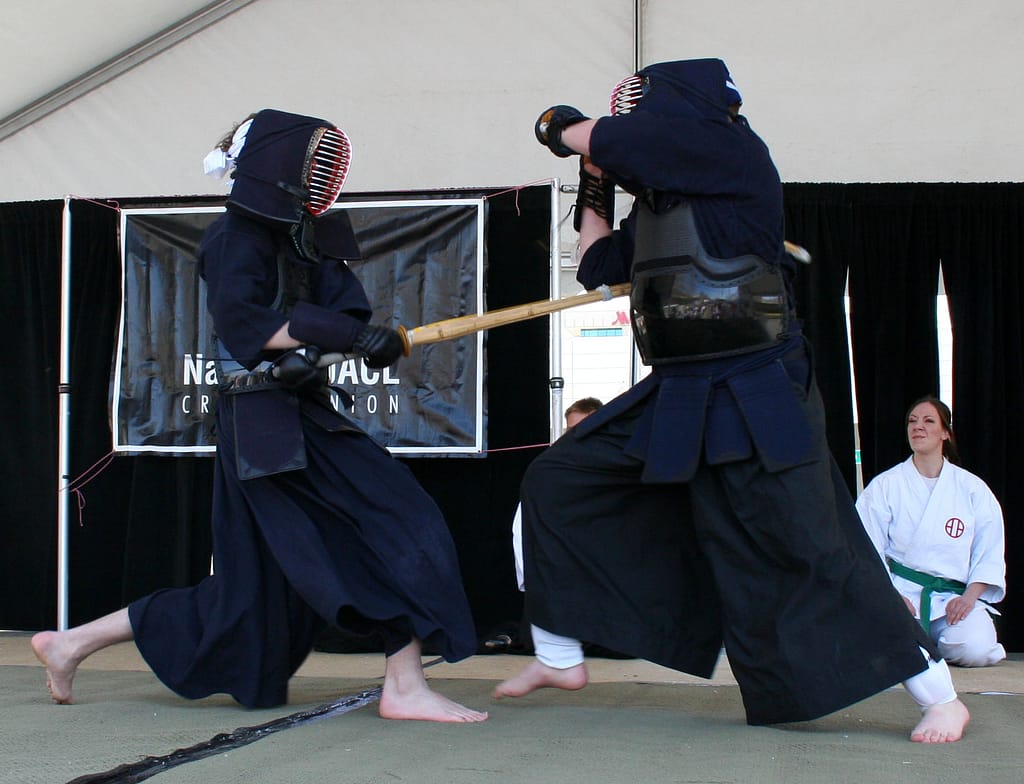
For this I wrote with Heiko Große of the Broadsword Academy Germany (who once was an active Kendo competitor himself and trained for over 10 years before switching to HEMA), about his past experiences and training with Kendokas of Germany’s national team.
He told me that the advanced Kendokas trained like they fought, always with full force in sparring and in competition, with the most notable difference being the mind-set and thus the will to experiment with techniques and tactics. He added that their sparring and free fighting (called Jigeiko) usually made up one third of the class and that he never witnessed anything more serious than bruising during this.
So how do they do it?
One thing to keep in mind is that Jigeiko is done under Kendos unified rules, which limit the target areas to the top of the head (Men), the forearms shortly behind the hand (Kote), the sides of the torso (Do) and the throat (Tsuki). Also while it’s legal to hold on to your opponent (for example if you lose your weapon), you’re not allowed to throw or do any extensive grappling.
So Kendoka have to be very precise in their attacks to score a point, which in turn means that these clearly defined targets can be properly protected without adding too much overall bulk, especially with their specific training swords in mind.
When asked about this Heiko attributed the lack of injuries to a carefully crafted balance of tournament rules, equipment, weapon and fighting style.
It’s also interesting to note that according to him, older Kendo rules and that of its predecessor Gekiken, allowed for a greater variety of techniques like thrusts to the face and breast, cuts to the legs, throws, foot sweeps and even ground fighting [7].
Now the question is this: is this a road we could go down, if we wanted to, using steel weapon simulators?
I get the impression, that most of the tournament critical people in HEMA fear exactly this kind of standardization of rule sets and equipment, while removing more and more parts of the allowed techniques for safety’s sake.
So I would take this as something not wished upon by the HEMA scene, but we can keep in mind, that it probably can be done.
HEMA
So let’s take a final look at HEMA itself. How do our own successful tournament fighters train and do they believe in hitting full force?
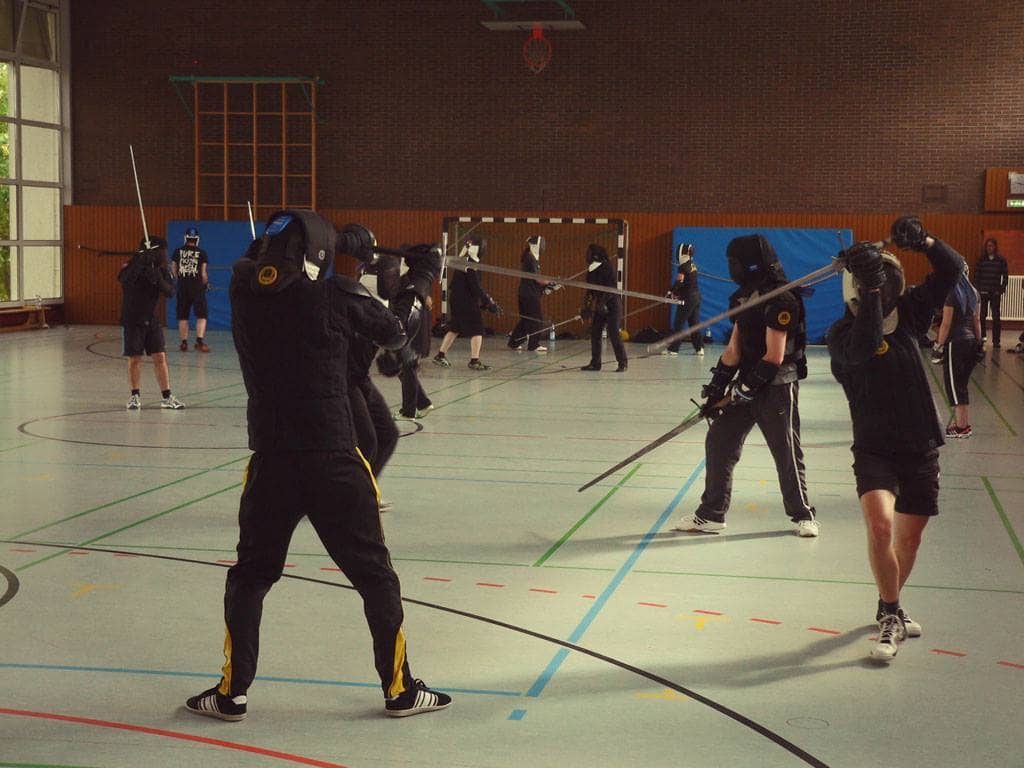
I talked about this (well it was more a Facebook chat really) with Axel Pettersson of GHFS, Anton Kohutovič of Trnavský šermiarsky cech and Ties Kool of HVN.
Ties notes, that he uses the same techniques in his sparring and tournament fights, with the only difference in how fast and hard he hits, while making the point that he never hits to hurt and that he tries to cut on target instead of going through. In a tournament he claims to fight with about 75% of force compared to 50% in training. He also doesn’t do any free sparring during the last 1,5 weeks of tournament preparation, relying only on controlled technical training with people he trusts to minimize the risk of injury.
He further told me that they rarely had injuries in their sparring over the course of the last three years, with the exception being broken fingers. Ties himself dislocated both of his shoulders due to unfortunate falls: once during a dagger demonstrations and once in training.
Axel told me that he rarely spars with 100% force, but notes that you can do it with a good training partner that is able to let go of the force generation right before impact, which according to him still results in a pretty hard hit that might give bruising, but avoids serious injury.
Axel himself claims to have never broken anything in training or competition, although their training contains a 20 – 30 minute sparring session. He notes that in general, the only injuries he and his students suffer are inflammations from over training.
Anton Kohutovič on the other hand, informed me that they use only slightly less power in training than during competitions, but made the point that they don’t rely too much on it and try not to hit too hard even during competitions. The main difference for him, is the very narrow set of techniques he relies on during competition.
He added that “The main goal in each competition is not to get injured […] to avoid risky situations and solve everything with the simplest possible solution” and that they rarely have injuries during their training, with him, so far, getting out of sparring completely unharmed.
Conclusion
HEMA is still a young martial art and continues to evolve, so we can and should learn a lesson or two from martial arts that existed before we started reviving our lost arts.
We are amateurs for the most part, with barely anyone living solely on his HEMA earnings, yet it puzzles me as to why some of us regularly train with far more force than even professional fighters. If these athletes don’t have to spar with full force to produce world class fighters that can handle themselves in the toughest full contact environments, why should we have to?
Now I absolutely advocate sparring, since I find it to be an invaluable learning tool and I think it’s fine -with the right equipment and partner- to up the force from time to time, but my conclusion from this research is that the bulk of our sparring should be done in a way that we do not injure each other.
This, again, sounds obvious for the most part, but it was hard for me to back up this “feeling” with some data until now.
I think that we should ask ourselves from time to time, if we will still be able to do HEMA in 10 or 20 years the way we train now and try to give ourselves an honest answer.
Accidents can always happen, but they are never acceptable parts of our training. Please be safe and smart about your sparring and try not to break anything.
Sources
- http://bleacherreport.com/articles/1994748-johny-hendricks-vs-robbie-lawler-how-safe-sparring-may-change-contact-sports
- http://www.historical-academy.co.uk/files/research/keith-farrell/Dementia%20Pugilistica%20in%20HEMA.pdf
- http://dogbrothers.ch/?page_id=28
- http://www.cagepotato.com/shinya-aoki-biggest-douchebag-japanese-mma-0/
- https://www.youtube.com/watch?v=I4i7tDGxEoM
- https://www.youtube.com/watch?v=wyopp0o2Erw
- A video containing Gekiken https://www.youtube.com/watch?v=6w0zNA_KocQ
- http://www.sherdog.com/fighter/Robbie-Lawler-2245
- http://www.sherdog.com/fighter/Johny-Hendricks-24539
Images
- BJJ: https://en.wikipedia.org/wiki/Brazilian_jiu-jitsu
- Wrestling: https://en.wikipedia.org/wiki/Wrestling
- MMA: https://de.wikipedia.org/wiki/Mixed_Martial_Arts
- Kendo: http://falln-stock.deviantart.com/art/Japanese-Festival-53-84067016
- Article Image: By Susan Sümer
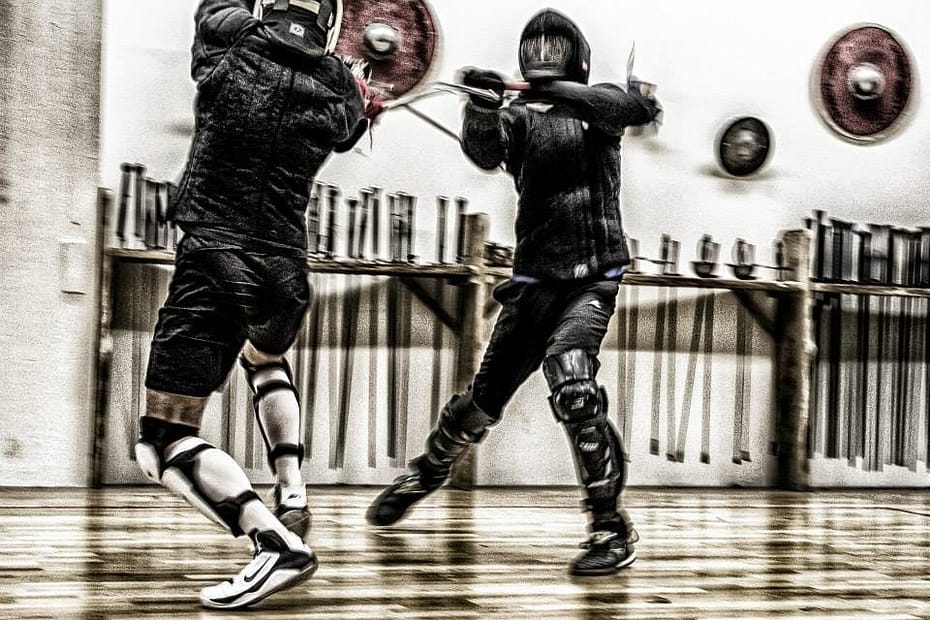
Pingback: HEMA vs BJJ - Jiujitsu Central
Die Kommentarfunktion ist deaktiviert.